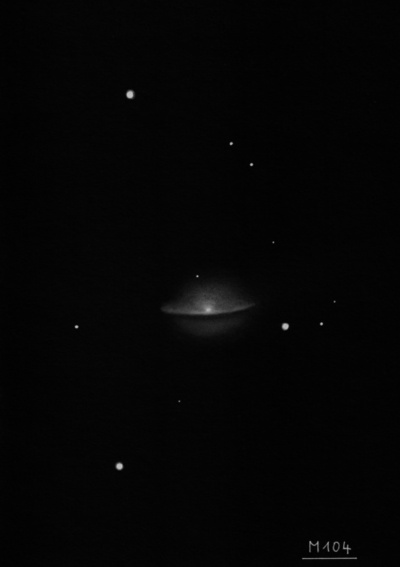Sombrero Galaxy
Sombrero Galaxy

15x50mm (6/19/08 and 4/6/13): easily visible in binoculars as a elongated glow with brighter center.
Pierre Méchain discovered M104 = NGC 4594 = H I-43 = h1376 on 11 May 1781, after Messier's final catalogue was sent to publication. The discovered was mentioned in a letter dated 6 May 1783 to Johann Bernoulli, the editor of the Berliner Astronomisches Jahrbuch. He wrote, "On May 11, 1781, I have discovered a nebula above Corvus; it did not appear to me to contain stars; it is faint & very difficult to see when the wires of the micrometer are illuminated; I have compared it on this day & the following to the Ear of Virgo [Spica], & I have derived its right ascension 187d 9' 42", its south. declin. 10d 24' 49". It is not included in the Connoissance des tems." The note was published near the end of the 1786 Jarbuch volume. Messier penciled in the position into his own copy of his catalogue, published in 1784. French astronomer Camille Flammarion introduced the new designation M104 in 1921.
As M104 wasn't published in Messier's catalogue, William Herschel was unaware of it and rediscovered it on 9 May 1784 (sweep 210). He wrote, "E, vBM, about 5 or 6' long, but daylight is too strong to see the whole extent of it. The bright place in the middle is prety large, but breaks off abruptly." He made a second observation on 11 Mar 1788 (sweep 819): "mE, from about 20° sp. to nf., BN, 4 or 5' long."
John Herschel was the first to note the dust lane. On 9 Mar 1828, he recorded "vB, vmE, in pos 2° np to sf; vsmbM to a nucleus; 5' l, 30" br, a bright star sp. There is a faint diffused oval light all about it, and I am almost positive that there is a dark interval or stratum separating the nucleus and the general mass of the nebula from the light above (south) of it. Surely no illusion." In his sketch (Fig. 50) he adds the remarks "The strong suspicion of a parallel appendage to the latter of these, is almost converted into certainty by its undoubted existence in V. 24 [NGC 4565], in which it was seen by two other observers as well as by myself." Later sketches were made by William Lassell in 1862 with his 48" and Wilhelm Tempel in 1882 with an 11" refractor. The first photo was taken by Isaac Roberts in April 1897.
Leland Copeland called M104 the "Sombrero" in the June 1942 issue of S&T. The back cover featured an image taken by the Mount Wilson 60-inch in 1916. The image is referred to as the "Sombrero nebula". The classic photo of M104 was made with the Palomar 200-inch in 1950 and published in the Hubble Atlas of Galaxies.
300/350mm - 13.1" (4/24/82): very bright, large, very elongated, arms long and thin. A prominent dark lane is visible along the length of the galaxy. Only a faint glow is visible to the south of the dust lane.
400/500mm - 17.5" (3/12/94): very bright, very large, elongated 3:1 E-W, 7.5'x2.5'. Very prominent dust lane along the entire length of the major axis and divides the core into two non-symmetric sections. The prominent section of the core is just north of the dark lane. Overall, the galaxy is brighter and much more extensive to the north of the lane. The portion of the core and halo south of the dust lane is much fainter, smaller and unconcentrated. A mag 10 star lies 4' WSW.
900/1200mm - 48" (2/20/12, 4/5/13, 4/30/19): stunning view of the jet-black super high-contrast dust lane at 375x. The fainter section of the galaxy south of the dust lane was quite prominent and nearly as extensive as the northern half and the central bulge region was noticeably thicker in proportion to the major axis than views in smaller scopes. I also clearly noticed that although the dust lane was very flat in the central region (oriented precisely E-W), it bent slightly north and widened just a bit on both the east and west ends of the disc, giving it a slightly warped appearance.
Notes by Steve Gottlieb